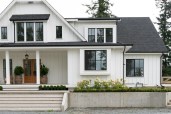Less Is More
The product isn’t quite as big as it used to be, thus producing smaller framing packages. New homes planned by designers such as Chekouras now average about 1,800 square feet, down from the 2,200-square-foot homes he designed during the housing boom for locations ranging from the woods and farms of northern Wisconsin to the aging industrial town of Green Bay to the vacation areas of Door County, Wis. Still, the new homes he designs are much larger than the average 1,400-square-foot plans he drew before the housing boom blimped out home sizes.
Average ceiling heights have dropped from 10 feet back down to eight feet. Two-car garages are once again in fashion, compared with the three- or even four-car garages common during the boom. Lot sizes are getting smaller too, as developers squeeze more housing units onto their land to help make up for lower unit prices.
“For a while, bigger was better,” said Chekouras. Today, his customers don’t want to pay the expensive utility bills associated with huge houses.
At the same time, customers are willing to invest in extra insulation to cut those utility bills. A growing number choose homes that meet the Energy Star standard for insulation and energy efficiency.
“About three-quarters of my customers do the extra insulation needed to meet Energy Star,” says Chekouras. “Before the boom, they didn’t even know what it was.”
To make room for more insulation, the lumberyard designers regularly employ six-inch studs rather than four-inch ones. Their plans also often raise the heel of roof trusses to make room for even more insulation.
Less Bling
Inside the building envelope, many of the flashy finishes that became popular during the housing boom have become much less common. One example: granite countertops, which can cost twice as much as some alternatives.
“People ask about granite countertops …it’s a status thing,” says Chekouras. “But when they see the price, they say no.”
In Pontiac, Ill., which was spared the housing boom and the bust that followed, about half of Swanson’s customers still buy expensive solid-surface countertops. But rather than granite, these prosperous farmers buy a composite countertop material made of ground quartz that is much harder and needs no sealant.
Stainless steel appliances are less common, the designers say, because folks are complaining about the constant need to clean fingerprints. Whirlpool tubs are also getting hard to find.
“I think more people are realizing that they don’t use them,” says Jim Rasmussen, a designer at Schoeneman’s Building Materials Center in Sioux Falls, S.D. Customers are more likely to spend money to turn a four-foot walk-in shower into a supershower, he says.
The same economizing trend extends to flooring. Thanks to the Internet and cable television, customers are aware of their options in building materials and eager to save money.
Renovation is also much more common, as customers build porches and additions onto existing homes rather than starting from scratch, according to Charlie Redetzke, a designer for Hilltop Lumber in Alexandria, Minn., a town in the popular Lakes Region vacation area.
On the other hand, “Customers who didn’t bat an eye at $25-a-yard carpet now stop over prices at $12 a yard,” says Redetzke. Many demand cheaper options they may have seen on cable television home renovation shows.
Even in these penny-pinching times, customers still will pay extra for hardwood or ceramic flooring in certain parts of the house, particularly in areas that get heavily used, designers say. Maintenance is the big issue.
Customers favor mid-priced hardwoods like maple or hickory, passing on expensive options like hand-scraped reclaimed lumber, with prices around $25 per square foot, or oak, the cheapest hardwood at about $5 per square foot.Easy maintenance is the motive since, unlike carpet, hardwood floors don’t need to be replaced every few years.
Many of the features favored by customers also appear on the checklists of green building advocates. Sustainable development disciples favor more compact houses on smaller lots with more insulation and finishes made from long-lasting materials. Even hardwood flooring makes the cut, since it is less likely to collect dust and cleaning chemicals than wall-to-wall carpeting.
But the motivation behind all these choices goes far beyond the green building movement, as customers create high-quality homes that conserve money over time.
“They’re willing to spend more because, I guess, it’s a homestead,” Swanson says. “They are buying for the long term.”
–Bendix Anderson is a freelance writer. He’s based in Brooklyn, N.Y.


